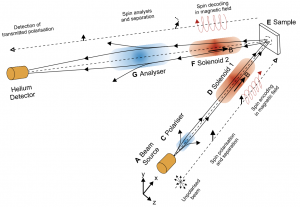Surface Helium-3 Spin Echo (HeSE) spectroscopy enables the studies of ultra-fast atomic-scale dynamics at surfaces. It is a Fourier transform spectroscopy which is based on atom scattering, and measures time-correlations at surfaces with atomic resolution, albeit in reciprocal space.[1] The conceptual experiment follows from neutron spin-echo spectroscopy, which allows to study ultra-fast dynamics of the bulk. A realisation of the concept to helium scattering was achieved by de Kieviet et. al.,[2] and later on, an application to surface dynamics was developed in Cambridge UK.[1, 3]

The experimental setup includes a source producing a helium-3 molecular beam which is then focused and polarised, and undergoes a series of magnetic manipulations prior and post scattering from the surface.[1] The change in the spin polarisation of the helium atoms due to the scattering from the surface is then measured using a sequence of a magnetic analyser and a magnetic-trap based ionising detector. The current practical temporal window of the Cambridge instrument is between sub-picosecond to about 2 nanosecond, with further extension anticipated in the near future.
With incomparable surface sensitivity and energy resolution of 3 microelectron volts, HeSE is best known for the unique information it provides on surfaces, in particular:
- atomic-scale friction.
- rate of molecular transport.
- energy landscapes.
- inter-adsorbate interactions at the low coverage and/or elevated temperature regime.
- lifetimes of surface phonons.
The information highlighted above is available in (nearly) any HeSE measurement, and is of high scientific value in its own right.

[1] AP Jardine et al. Helium-3 spin-echo: Principles and application to dynamics at
surfaces”. In: Progress in Surface Science 84.11-12 (2009), pp. 323-379.
[2] M DeKieviet et al. Surface science using molecular beam spin echo”. In: Surface
science 377 (1997), pp. 1112-1117
[3] G Alexandrowicz and AP Jardine. Helium spin-echo spectroscopy: studying surface dynamics with ultra-high-energy resolution”. In: Journal of Physics: Condensed Matter 19.30 (2007), p. 305001
